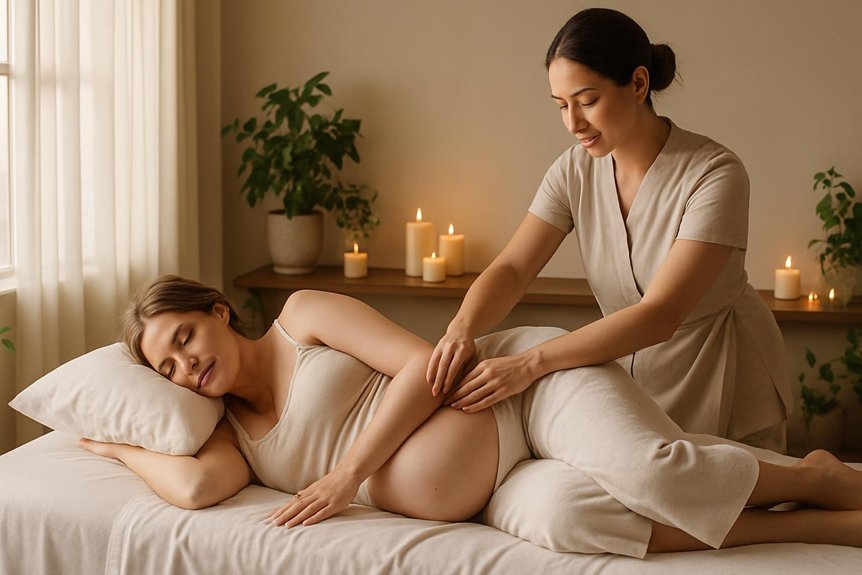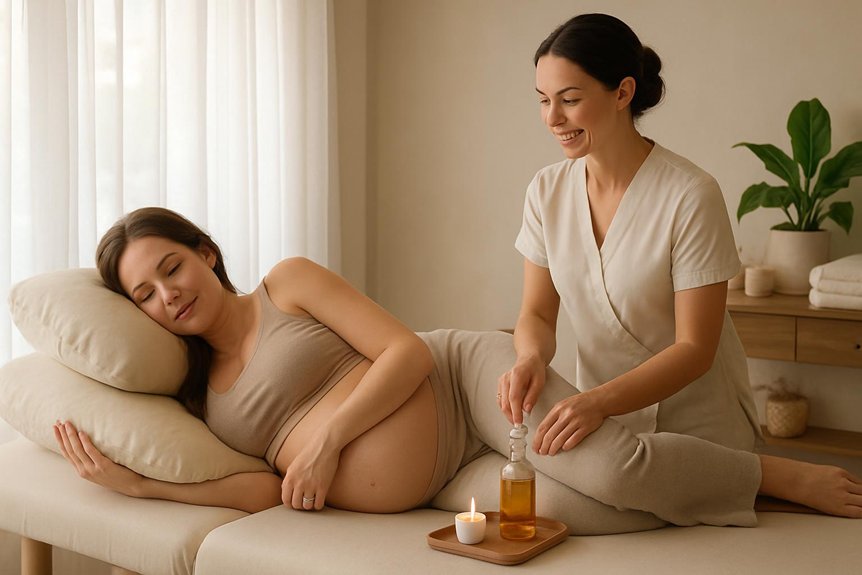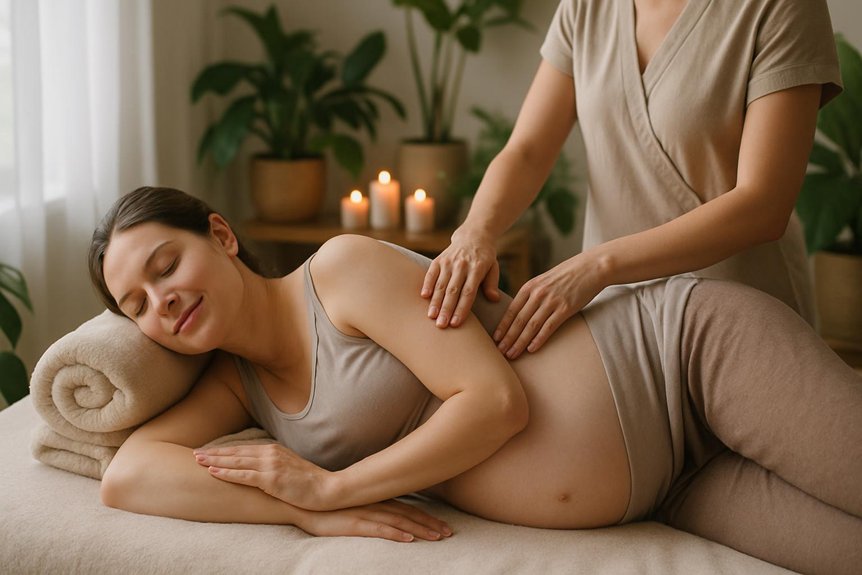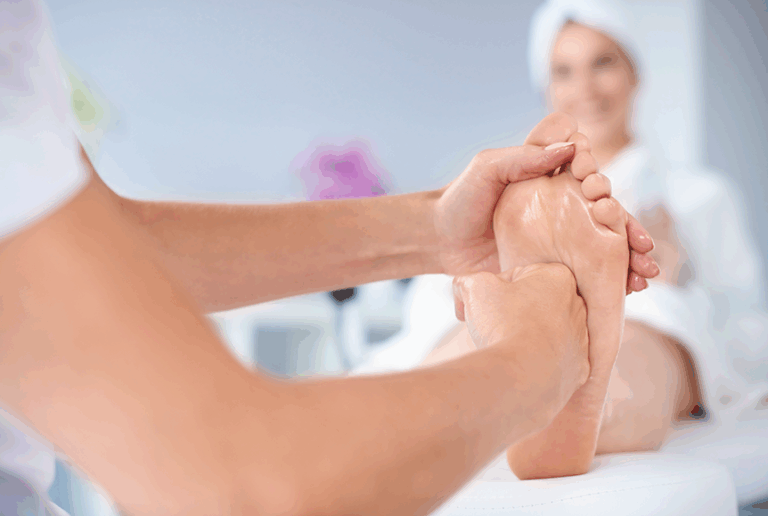Prenatal massage is generally recommended after the first trimester, or from week 13 onward, when early risks have lessened. Professional assessment and guidance from healthcare providers help guarantee safety based on individual health and pregnancy stage. Therapists use gentle techniques and safe positioning to support comfort and wellbeing. Special precautions are taken in each trimester to address changing needs and limit risks. Further information will clarify adaptations, safety measures, and how to get the most benefit from prenatal massage.
Understanding Pregnancy Massage and Its Benefits

What makes this therapy distinct from other therapeutic treatments? This specialised approach is tailored to the unique physiological and emotional needs experienced during pregnancy.
At Spa & Massage, therapists are trained to adjust positioning, pressure, and techniques to prioritise safety and comfort for both mother and baby.
Gentle strokes relieve muscular tension, particularly in the lower back, hips, and legs, areas commonly affected by pregnancy.
Beyond physical relief, prenatal massage provides nurturing support, fostering a sense of calm and connection during a transformative time.
The use of carefully selected oils and supportive cushioning enhances relaxation while minimising risks.
Clients often report improved sleep, reduced anxiety, and a deeper sense of wellbeing—a testament to the holistic benefits delivered through expert, attentive care.
Some practitioners incorporate the healing power of reflexology into prenatal massage, harnessing its potential to support overall wellness and further enhance relaxation.
The Best Time to Begin This Therapy
Determining the safest time to begin prenatal massage is essential for both mother and baby.
At Spa & Massage, therapists provide guidance based on each trimester to maximise benefits and prioritise well-being.
Professional assessment guarantees that treatment is tailored to individual needs and follows best practices throughout pregnancy.
Safe Prenatal Massage Timing
When considering the ideal time to begin this therapy, clinical guidelines and client safety take precedence.
At Spa & Massage, therapists are trained to follow the safest approach: prenatal massage is generally recommended after the first trimester, once the risk of early complications has decreased.
This timing allows expectant mothers to experience nurturing touch and relaxation in a way that supports both physical and emotional wellbeing.
Careful assessment is always conducted, and each session is tailored to meet individual needs, taking into account any specific health considerations.
Communication remains central—clients are encouraged to share how they’re feeling, so the therapist can respond with appropriate techniques and positioning.
This approach guarantees that every moment is both professionally guided and deeply comforting, fostering trust and connection.
Benefits by Trimester
How do the benefits of prenatal massage evolve across each trimester? In the first trimester, gentle massage may help ease anxiety and promote emotional well-being, as the body adjusts to rapid hormonal changes.
During the second trimester, as physical discomfort and musculoskeletal tension often increase, targeted massage can reduce backaches, leg cramps, and swelling, fostering a sense of deep relaxation and connection to one’s changing body.
By the third trimester, when fatigue, joint strain, and sleep difficulties are common, expertly adapted massage techniques—such as those used at Spa & Massage—can offer comfort, improve circulation, and support restful sleep.
Throughout pregnancy, each trimester presents unique needs, and tailored massage provides safe, nurturing support for both physical relief and emotional intimacy, enhancing the prenatal experience.
Professional Therapist Guidance
As each stage of pregnancy brings distinct physical and emotional needs, the timing of massage becomes a matter of careful consideration.
Professional guidance is essential when deciding when to begin this therapy.
At Spa & Massage, therapists recommend waiting until after the first trimester, when the risk of miscarriage decreases and the body is more adapted to pregnancy changes.
Therapists with specialised training assess each client’s health, comfort, and medical history before proceeding.
They tailor techniques to accommodate physical changes and ensure safety, such as using supportive positioning and gentle pressure.
Open communication with both a healthcare provider and a qualified therapist is advised, allowing expectant mothers to enjoy the nurturing benefits of massage at the most appropriate and safe stage of their pregnancy journey.
Safety Considerations for Each Trimester

Although this therapy is widely regarded as beneficial, its safety depends on careful consideration of each trimester’s unique physiological changes. During the first trimester, caution is paramount due to the increased vulnerability of early pregnancy; many therapists at Spa & Massage recommend waiting until after week 12 to begin treatment.
In the second trimester, side-lying positioning and gentle techniques help accommodate a growing abdomen while supporting circulation and relaxation.
The third trimester requires additional modifications, with attention to joint stability and the mother’s comfort, as the body prepares for birth.
Throughout pregnancy, Spa & Massage therapists avoid deep pressure on certain areas, such as the lower back and abdomen, and always prioritise open communication to address any discomfort, creating a safe, nurturing experience at every stage.
How Our Therapists Tailor to This Therapy
At Spa & Massage, therapists use specialised techniques that are gentle and adapted to the unique needs of each stage of pregnancy. Careful attention is given to positioning and support, with pillows and bolsters ensuring comfort and safety throughout the session.
Treatments are further tailored to address common discomforts such as back pain, swelling, and tension, helping clients feel relaxed and cared for.
Adapting Massage Techniques Safely
When providing prenatal massage, Spa & Massage therapists prioritize safety and comfort by meticulously adapting techniques to suit each stage of pregnancy. Their approach emphasises gentle, nurturing strokes and avoids deep pressure on sensitive areas, particularly the abdomen and lower back.
Therapists are trained to recognise physical changes such as joint instability and increased blood flow, adjusting their methods accordingly. At every session, they assess individual needs, ensuring that only suitable techniques are used to ease tension, reduce swelling, and promote relaxation.
Communication is encouraged, allowing clients to express preferences and sensitivities freely. This attentive, expert care guarantees that each massage supports both maternal wellbeing and emotional reassurance, creating a sanctuary of trust and serenity throughout the pregnancy journey at Spa & Massage clinics.
Customised Positioning and Support
Alongside carefully adapted techniques, Spa & Massage therapists place significant emphasis on customised positioning and support during this massage session. Recognising the unique changes the body undergoes at each stage, therapists employ specialised cushioning and adjustable bolsters to confirm clients are never placed in positions that compromise comfort or safety.
Side-lying positioning is commonly used, thoughtfully arranged to relieve pressure on the abdomen and lower back. Therapists vigilantly monitor alignment throughout the session, responding immediately to any sign of discomfort.
Every aspect of support is tailored—pillows, towels, and padding are adjusted to cradle the body, promoting relaxation and a sense of security. This attentive approach reflects Spa & Massage’s commitment to providing a nurturing and protective environment for expectant clients.
Targeting Pregnancy-Related Discomfort
Recognising the diverse physical challenges that accompany pregnancy, Spa & Massage therapists employ a highly individualised approach to alleviate common sources of discomfort such as lower back pain, pelvic tension, swollen limbs, and muscle fatigue.
Each session begins with a careful consultation, ensuring all techniques and pressures are suited to the client’s unique needs and stage of pregnancy. Therapists use gentle, targeted strokes to ease muscular tension and enhance circulation, while specific attention is given to areas prone to swelling or strain.
Safe, pregnancy-appropriate massage oils are selected to nurture sensitive skin. Throughout, clear communication is prioritised, allowing adjustments for comfort and reassurance.
This attentive process fosters trust, eases discomfort, and promotes emotional well-being, supporting both mother and baby at every stage.
Common Concerns and How We Address Them

As clients consider prenatal massage, several important concerns often arise regarding safety, comfort, and suitability at various stages of pregnancy. Spa & Massage recognises these sensitivities and addresses them with expert care.
Therapists are trained to use specialised techniques and positioning, such as side-lying support with soft bolsters, to ensure maternal and fetal safety. Only gentle, nurturing pressure is applied, and specific areas—such as the lower back and abdomen—are treated with heightened caution or avoided, following clinical guidelines.
For those worried about oils or products, Spa & Massage uses only hypoallergenic, pregnancy-safe options to minimise risk of irritation or adverse reactions.
Individual needs and comfort are continually prioritised, with therapists engaging in open communication to adapt each session. This careful, compassionate approach fosters trust and reassurance throughout the pregnancy journey.
Booking Your First Session
When is the right moment to schedule a massage? Clinical guidance recommends waiting until after the first trimester, typically from week 13 onward, to prioritise safety for both mother and baby.
At Spa & Massage, experienced therapists encourage expectant mothers to consult their healthcare providers before booking, ensuring the timing is tailored to individual health needs.
When making an appointment, sharing details such as weeks of pregnancy, any medical conditions, and areas of discomfort allows therapists to create a supportive and nurturing experience.
Many clients find comfort in reserving a quiet, familiar clinic location—such as Crouch End or Richmond—for added peace of mind.
Thoughtful preparation and open communication help foster trust, intimacy, and relaxation from the very first visit.
Aftercare Tips for Expectant Mothers
Following a prenatal massage, careful aftercare supports both comfort and overall wellbeing for expectant mothers. At Spa & Massage, therapists advise clients to hydrate generously, as this aids in flushing out toxins and supports circulation.
Gentle stretching or light walking, when recommended, can maintain the benefits of the massage and ease any lingering tension. Rest is equally essential; allowing time to relax helps the body integrate the positive effects of the treatment.
Clients are encouraged to note any unusual reactions and communicate these to their healthcare provider. In our clinics, soothing herbal teas and a calm environment further nurture post-massage tranquility.
Prioritising aftercare guarantees that the nurturing touch received extends into daily life, supporting both mother and baby’s ongoing wellbeing.
Conclusion
In sum, prenatal massage—when expertly timed and tailored—serves as a gentle companion to the expectant mother’s journey, nurturing both body and mind. Is it not reassuring to know that, with the guidance of skilled therapists and evidence-based protocols, comfort need not come at the expense of safety? With careful attention to individual needs and each trimester’s unique requirements, prenatal massage offers a haven of relief, fostering wellbeing at every stage of this remarkable transformation.



